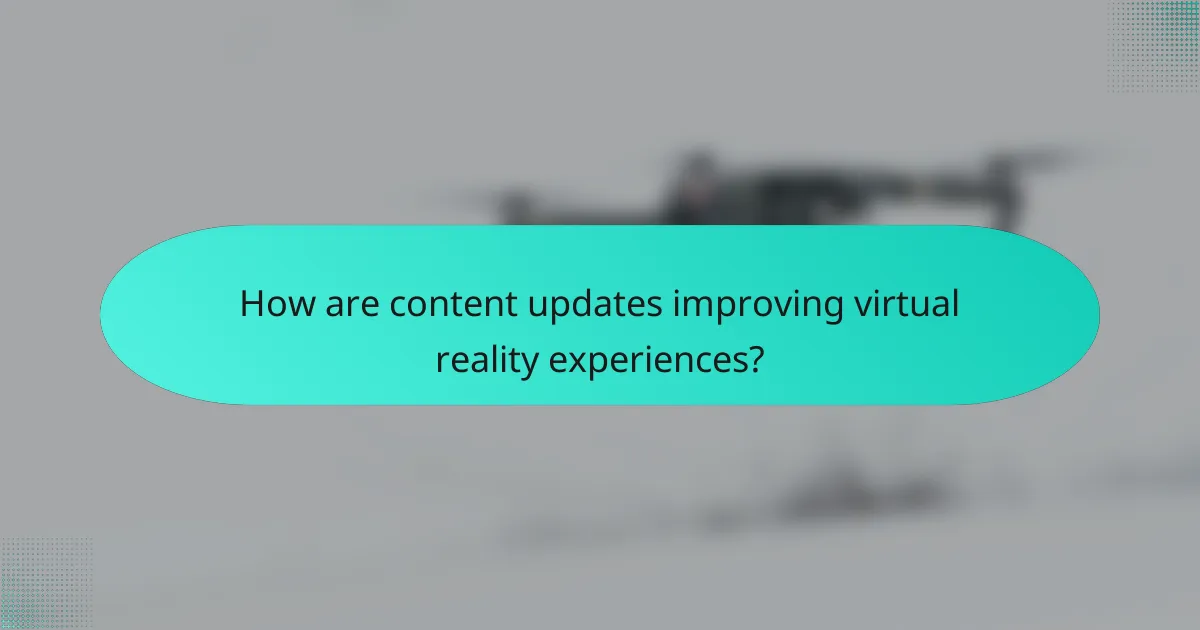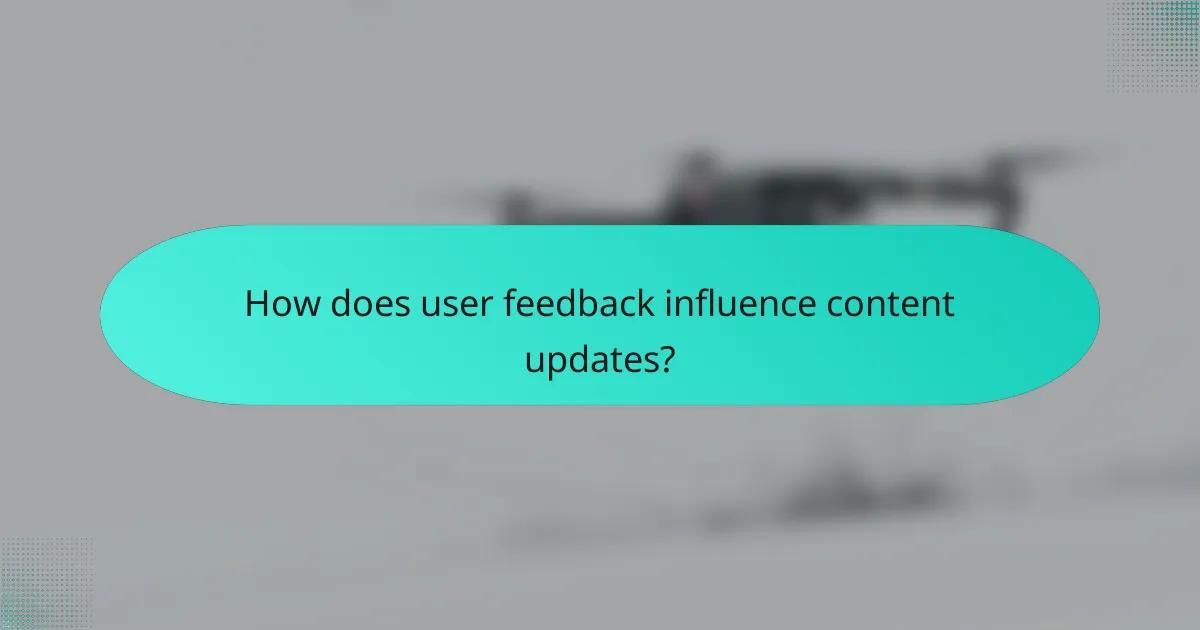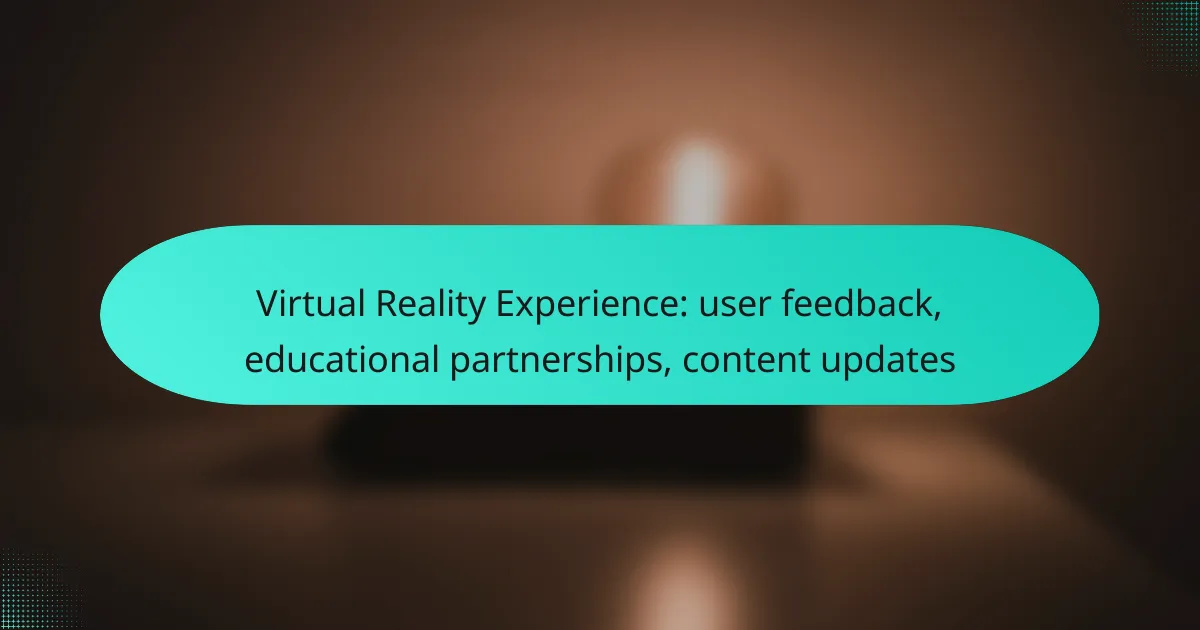In the realm of virtual reality, user feedback serves as a vital tool for developers, guiding enhancements that boost engagement and satisfaction. Collaborations with educational institutions further enrich VR content, aligning immersive experiences with curriculum standards. Regular content updates are essential for maintaining user interest, introducing new features, and ensuring a seamless experience.

How is user feedback shaping virtual reality experiences in the UK?
User feedback is crucial in refining virtual reality experiences in the UK, as it directly informs developers about user preferences and pain points. By actively gathering and analyzing feedback, companies can enhance user engagement and satisfaction, leading to more effective and immersive VR content.
User satisfaction surveys
User satisfaction surveys are a primary tool for collecting feedback on virtual reality experiences. These surveys typically include questions about usability, content quality, and overall enjoyment, allowing developers to gauge user sentiment effectively. In the UK, many VR companies conduct these surveys post-experience to ensure timely insights.
Surveys can be distributed through various channels, such as email, in-app prompts, or social media, and often include rating scales and open-ended questions for detailed responses. Analyzing this data helps identify common trends and areas needing improvement.
Real-time feedback integration
Real-time feedback integration allows developers to make immediate adjustments based on user interactions during the VR experience. This can include modifying difficulty levels, adjusting content pacing, or enhancing user interfaces based on direct input. Such responsiveness can significantly improve user satisfaction and retention.
For instance, VR platforms may implement in-experience prompts that encourage users to provide feedback on specific features, enabling developers to address issues as they arise. This agile approach ensures that the VR experience evolves in line with user expectations.
Case studies from UK developers
Several UK developers have successfully utilized user feedback to enhance their virtual reality offerings. For example, a London-based VR studio revamped its educational content after receiving feedback that users found certain modules too complex. By simplifying these modules, they increased user engagement and comprehension.
Another case involved a gaming company that incorporated user suggestions to improve multiplayer functionality. By addressing connectivity issues highlighted in feedback, they significantly boosted player satisfaction and retention rates. These examples illustrate the tangible benefits of integrating user feedback into the development process.

What educational partnerships enhance virtual reality content?
Educational partnerships play a crucial role in enhancing virtual reality (VR) content by providing access to expertise, resources, and innovative teaching methods. Collaborations with academic institutions and educational platforms help create immersive learning experiences that are aligned with curriculum standards.
Collaborations with UK universities
Collaborating with UK universities allows VR content developers to leverage cutting-edge research and pedagogical strategies. These partnerships often involve co-developing VR modules that are tailored to specific subjects, such as science or history, ensuring that the content is both educational and engaging.
For instance, a partnership with a university’s engineering department might result in a VR simulation that allows students to explore complex machinery in a virtual lab environment. This hands-on experience can significantly enhance understanding and retention of technical concepts.
Partnerships with educational platforms
Partnerships with established educational platforms enhance the distribution and accessibility of VR content. These platforms often have a large user base and can integrate VR experiences into their existing curriculum, making it easier for educators to adopt new technologies.
For example, a collaboration with an online learning platform could lead to the inclusion of VR modules in courses on environmental science, allowing students to virtually explore ecosystems and understand their dynamics. This integration can improve engagement and learning outcomes.
Impact on curriculum development
Educational partnerships significantly impact curriculum development by ensuring that VR content meets educational standards and learning objectives. Collaborating with educators helps identify key competencies that VR experiences should address.
Moreover, these partnerships can lead to the creation of interdisciplinary content that combines subjects, such as using VR to teach both art and history through virtual museum tours. This approach not only enriches the curriculum but also fosters critical thinking and creativity among students.

How are content updates improving virtual reality experiences?
Content updates enhance virtual reality experiences by introducing new features, fixing bugs, and expanding available content. These updates ensure that users have access to the latest technology and immersive scenarios, which keeps the experience fresh and engaging.
Regular software updates
Regular software updates are essential for maintaining the performance and security of virtual reality systems. These updates often include bug fixes, performance enhancements, and compatibility improvements with new hardware. Users should regularly check for updates to ensure they are benefiting from the latest advancements.
For example, a VR headset might receive updates that reduce latency, improve tracking accuracy, or enhance visual fidelity. Staying current with these updates can significantly enhance the overall user experience.
User-generated content features
User-generated content features allow users to create, share, and access a wider variety of immersive experiences. Platforms that support user-generated content often include tools for designing custom scenarios, which can lead to innovative and diverse applications in education, gaming, and training.
Encouraging users to contribute content fosters a community-driven environment, where experiences can be tailored to specific interests or educational needs. This not only enriches the content library but also promotes collaboration among users.
New immersive scenarios
New immersive scenarios are regularly added to virtual reality platforms, providing fresh experiences for users. These scenarios can range from educational simulations to interactive games, catering to various interests and learning objectives.
For instance, educational VR applications might introduce historical reenactments or scientific explorations that allow users to engage with content in a hands-on manner. Regularly updating these scenarios keeps users engaged and encourages repeated use of the platform.

What are the key criteria for selecting virtual reality platforms?
When selecting virtual reality platforms, consider user interface, content diversity, and technical support. These criteria ensure a seamless experience, a wide range of educational materials, and reliable assistance when needed.
User interface and experience
The user interface (UI) and overall experience are crucial for effective engagement in virtual reality. A well-designed UI should be intuitive, allowing users to navigate easily without extensive training. Look for platforms that offer customizable settings to enhance personal comfort and accessibility.
Consider the immersion level provided by the platform. Features like haptic feedback, spatial audio, and realistic graphics can significantly enhance the user experience. Test different platforms to find one that feels most comfortable and engaging for your specific needs.
Content library diversity
A diverse content library is essential for maximizing the educational potential of a virtual reality platform. Look for platforms that offer a wide range of subjects, from science and history to art and language learning. This variety ensures that users can explore different topics and find materials that suit their interests and educational goals.
Evaluate the frequency of content updates as well. Platforms that regularly add new materials or collaborate with educational institutions can provide fresh and relevant resources, keeping users engaged and informed about the latest developments in their fields of interest.
Technical support and community
Reliable technical support is vital when using virtual reality platforms, especially for educational purposes. Ensure the platform offers accessible support channels, such as live chat, email, or phone assistance. A responsive support team can help resolve issues quickly, minimizing downtime and frustration.
Community engagement is another important factor. Platforms with active user communities can provide valuable peer support, sharing tips and experiences that enhance the overall learning process. Look for forums, social media groups, or user events that foster collaboration and knowledge sharing among users.

How does user feedback influence content updates?
User feedback plays a crucial role in shaping content updates for virtual reality experiences. By actively listening to users, developers can prioritize enhancements that align with user needs and preferences, ensuring a more engaging and relevant experience.
Prioritizing user-requested features
When users express specific requests for features, these suggestions often take precedence in the development pipeline. For instance, if a significant number of users ask for multiplayer capabilities, developers may prioritize this feature in their next update. This approach not only satisfies user demand but also fosters a sense of community and loyalty among users.
To effectively prioritize these requests, developers can categorize feedback into themes, such as gameplay mechanics, user interface improvements, or content expansions. This helps in identifying the most requested features and addressing them systematically.
Feedback loops with developers
Establishing feedback loops between users and developers is essential for continuous improvement. This can be achieved through surveys, forums, or direct communication channels where users can share their experiences and suggestions. Regularly engaging with users allows developers to gather insights and clarify any misunderstandings about features or content.
Moreover, developers can provide updates on how user feedback is being implemented, creating transparency and encouraging further participation from the community. This ongoing dialogue ensures that users feel valued and heard, which can lead to more constructive feedback.
Analyzing usage data
In addition to direct user feedback, analyzing usage data provides valuable insights into how users interact with the virtual reality experience. Metrics such as session duration, feature usage frequency, and drop-off points can highlight areas needing improvement. For example, if data shows that users frequently abandon a specific level, it may indicate that the level is too difficult or unengaging.
Developers should regularly review this data to identify trends and make informed decisions about content updates. Combining quantitative data with qualitative feedback creates a comprehensive understanding of user behavior, allowing for more targeted enhancements.

What emerging trends are shaping the future of virtual reality in education?
Emerging trends in virtual reality (VR) for education include increased accessibility through mobile platforms and the integration of artificial intelligence (AI) in virtual environments. These developments are making immersive learning experiences more available and personalized for students worldwide.
Increased accessibility through mobile VR
Mobile VR is transforming education by allowing users to access virtual environments using smartphones and affordable headsets. This trend reduces the cost barrier associated with traditional VR setups, making it feasible for schools and students to adopt this technology.
For example, platforms like Google Cardboard and Oculus Quest enable learners to experience VR lessons without the need for high-end equipment. Educational institutions can leverage these mobile solutions to implement engaging content in classrooms, enhancing student participation and understanding.
Integration of AI in virtual environments
The integration of AI in virtual reality is enhancing the interactivity and personalization of educational experiences. AI algorithms can adapt content based on individual learning styles and progress, providing tailored feedback and support to students.
For instance, AI-driven avatars can simulate real-time interactions, allowing students to practice language skills or engage in problem-solving scenarios. This level of customization not only improves learning outcomes but also keeps students motivated and engaged in their studies.
